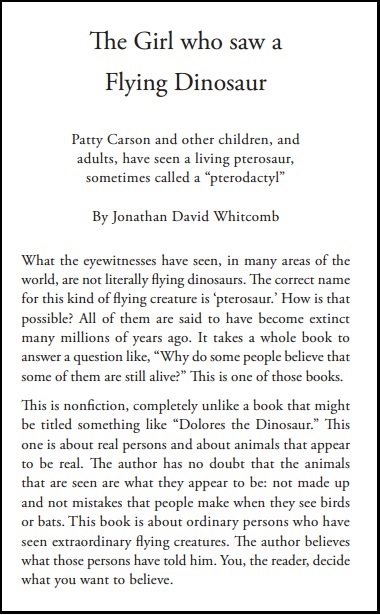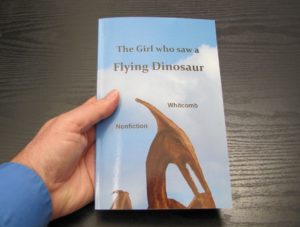New Book About Living Pterosaurs
The nonfiction cryptozoology author Jonathan Whitcomb wrote the book The Girl who saw a Flying Dinosaur, which was published by the Createspace publishing platform on November 8, 2018. The intended readers are between the ages of eight and fourteen, for this short paperback.
In spite of the title, this nonfiction book is not technically about dinosaurs but about reported sightings of apparent pterosaurs, flying creatures that have long been thought to have all gone extinct long ago. The sightings covered in The Girl who saw a Flying Dinosaur are in the following locations:
- Papua New Guinea (seven)
- Los Angeles County, California (four)
- Guantanamo Bay, Cuba (three)
The ten reported benefits for readers, listed by Whitcomb on the Amazon page, include these:
- Is understandable yet stimulating for kids and teens of about 8-14 years old
- Tells you not WHAT to think, like many other nonfictions, but HOW to think about possibilities
- By a positive example, invites you to use critical thinking
Title Page of the Book

Quotation
The following three paragraphs, submitted by the author, are taken from page 54:
“In Western countries, people are taught from early childhood that all species of dinosaurs and pterosaurs became extinct many millions of years ago. That means those who live in countries like the United States assume none of those animals could now be alive. When those people read or hear about somebody seeing a living pterosaur, they do not believe it, with almost no exceptions.
“My associates and I are some of those exceptions. We know that not all species of pterosaurs became extinct. Some of us have talked with natives of non-Western countries, persons who have seen animals like the ropen. That has helped us to be open minded when Americans and others tell us that they have seen a living pterosaur.
“I understand that all those things that I’ve just told you may not, by themselves, prove that one or more species of these wonderful flying creatures are still living. I’ve told you all those things to prepare you to learn about how I came to be sure that at least a few species of pterosaurs are still living.”
Basics
The following is taken from the Amazon page for The Girl who saw a Flying Dinosaur:
Paperback; $7.80
CreateSpace Independent Publishing Platform (November 8, 2018)
“Patty Carson and other children, and teenagers and adults, have seen a living pterosaur, sometimes called a pterodactyl”
56 pages; 8½ by 5½ (inches); English
ISBN-13: 978-1727778847
Front cover of the book
###
.
Two books about living pterosaurs
Live Pterosaurs in America (third edition) and The Girl who saw a Flying Dinosaur
.
This post lists 40 states where sightings have been reported (plus the District of Columbia): encounters with apparent non-extinct pterosaurs.
.
“The Girl who saw a Flying Dinosaur is a nonfiction book, but it’s not technically about dinosaurs: It’s a short cryptozoology book about apparent living pterosaurs.”
.
Pterodactyls that are not extinct
“Many species of pterosaurs have lived on this planet at some time in the past. What evidence is there that all of those species have become extinct? NONE!”
